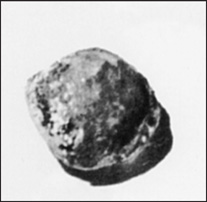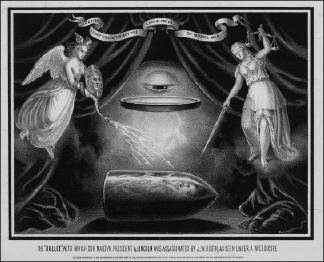Bloody Times (7 page)
Authors: James L. Swanson

Bloody relic: a pillow from Lincoln’s deathbed.
Mary Lincoln recoiled. “‘That is horrid! I wish you had not told it. I am glad that I don’t believe in dreams, or I should be in terror from this time forth.’”
“‘Well,’” replied the president, “‘it is only a dream, Mary. Let us say no more about it, and try to forget it.’”
Now Lincoln’s nightmare had come true.
The news of the attacks on Lincoln and Seward stunned Washington. Crowds from all over the city came to stand outside the Petersen house, and many tried to enter but were turned back by soldiers guarding the door. One person who was allowed inside was Benjamin Brown French, commissioner of public buildings and grounds. He was in charge of all of the major public buildings in Washington. If Lincoln died, he would have much to do in the next few days. It would be his responsibility to decorate the city with the symbols of mourning.
French had slept through the night and had not heard about Lincoln’s murder until the morning of April 15. When he woke, he saw that the streetlamps were still burning, although it was daylight. “I lay awake, perhaps ½ an hour,” he remembered, “& seeing that they were still burning, I arose and saw a sentry passing before my house. I thought something wrong had happened, so dressed & went down & opened the front door.”
A soldier came along and said, “Are not the doings of last night dreadful?” French asked what he meant by that. The soldier replied, “Have you not heard?” and told French that the president had been shot in Ford’s Theatre “and Secretary Seward’s throat cut in his residence.” French ordered the Capitol building closed and hurried to the Petersen house. There he found Lincoln, who was still alive, in the back bedroom. As he hovered over the deathbed in the crowded little bedroom, perhaps he already wondered: Where, in all of Washington, could he hope to find enough black mourning
crepe
and bunting?

An early broadside announcing Lincoln’s death.
Early on April 15 Dr. Leale knew that Lincoln would not live long: “As morning dawned it became quite evident that he was gradually sinking,” he remembered. It was past 6:00
A.M.
when Mary Lincoln returned to the bedroom. One of the doctors there recalled the scene. Mary fell in a faint, and when she awoke, she was taken to the bed to speak to her dying husband. “‘Love,’ she exclaimed, ‘live but one moment to speak to me once—to speak to our children.’”
As Lincoln’s breathing became louder and more labored, Mary cried out with fear and again fell fainting to the floor. Edwin Stanton heard her and came in from the room next door. He ordered, “Take that woman out and do not let her in again.” He was obeyed. Mary Lincoln never saw her husband alive again.
At 7:22
A.M.
on April 15, Abraham Lincoln died.

The bloody death bed shortly after Lincoln’s body was removed.
But what had begun in the little back room of a boardinghouse in downtown Washington would not end with Lincoln’s death. Soon the assassination would set in motion strong forces, the likes of which America had never seen. In the days to come, millions of Americans would join the procession that had begun that night when a handful of their fellow citizens made a pilgrimage to look upon their dying president.
Jefferson Davis awoke on the morning of April 15 not knowing anything about what had taken place in Washington. Davis did not know John Wilkes Booth, and had not sent him to kill Lincoln. Nor did Davis know that Booth was on the run, the prey of what would soon become a nationwide manhunt. He had no idea that within hours his longtime archenemy, Vice President Andrew Johnson, would succeed Lincoln as president. Johnson was a hardened foe of Southern plantation owners. The South could expect no mercy from him.
Worse, this morning’s newspapers accused Davis himself of being the mastermind behind the great crime. Many demanded Davis’s death by hanging or horrible torture. But Jefferson Davis was in the dark. For several days he would not know that Abraham Lincoln was dead.
Davis left Greensboro on April 15. Secretary of the Navy Mallory encouraged the president to not just get out of Greensboro, but to flee the country. There was no more hope of a military victory, Mallory believed. Davis should make himself “ready to cross the Mississippi and get into Mexico, or to leave the coast of Florida for the Bahamas or Cuba.”
But Mallory could see that Jefferson Davis had no intention of leaving the country as long as there were any soldiers willing to fight for his cause. If his staff had known that Lincoln had just been murdered, they might have demanded that Davis flee to escape the North’s vengeance. But they did not know, and so they packed up for the next stage of their journey south.
There were no trains at Greensboro, so Davis’s party switched to horses, wagons, and carts. They left Greensboro on horseback on the afternoon of April 15. Burton Harrison wrote that the roads were hard to travel on: “Heavy rains had recently fallen. . . . The soil was a sticky red clay, the mud was awful.”
On the morning of April 15, what thoughts must have raced through Edwin Stanton’s mind as he left the Petersen house? He kept no diary, so we do not know exactly what he was thinking. But there were questions that must have weighed heavily on him. Where were the assassins? Would there be more attacks? And what about Lincoln’s funeral? There must be one. But Stanton had no time to plan it. He must find someone to take over this important task. But who? And where would the president be buried? And the Union must still win the war.
But first it was time to bring Abraham Lincoln home to the White House. Lincoln’s body had been placed in a plain wooden box. Soldiers carried it into the street and placed it in a horse-drawn hearse. All of the soldiers in the procession, even the officers, walked rather than rode their horses. They removed their hats and marched bareheaded. It was a sign of respect for their fallen commander. There was no band, no drums. The officers set the pace with the thud of their own steps on the dirt street. It would be the first of three Lincoln death processions in Washington.
One observer remembered looking out the window to watch Lincoln’s body pass by. “I stepped to the window and saw the coffin of the dead President being placed in the hearse which passed up Tenth street to F and thus to the White House. . . . My hand involuntarily went to my head in salute as they started on their long, long journey back to the prairies and the hearts he knew and loved so well, the mortal remains of the greatest American of all time.”
A newspaper reporter, wandering the streets, met the funeral procession on its way. “Wandering aimlessly up F Street toward Ford’s Theater,” he wrote, “we met a tragical procession. It was headed by a group of army officers walking bareheaded, and behind them, carried tenderly by a company of soldiers, was the
bier
of the dead President, covered with the flag of the Union, and accompanied by an escort of soldiers who had been on duty at the house where Lincoln died. . . . Every head was uncovered, and profound silence which prevailed was broken only by sobs and by the sound of the measured tread of those who bore the martyred President back to the home which he had so lately quitted full of life, hope, and cheer.”
Arriving at the White House, the soldiers carried the temporary coffin into the Guest Room. They removed the flag that draped the box and then unscrewed the lid. They lifted the body and laid it on boards supported by wood sawhorses. They unwrapped the bloody flag from around Lincoln’s body. At the Petersen house, his clothes—suit coat, torn shirt, pants, plus the contents of his pockets—had been tossed in the box. Somebody had forgotten his boots; they were still under Willie Clarke’s bed. His tie was missing—somebody had already taken it. Abraham Lincoln lay naked on the boards. He had been dead for fewer than five hours. His body was still cooling.
Several doctors were waiting to perform an autopsy—an examination of Lincoln’s dead body. They prepared their instruments. Dr. Janvier Woodward would expose the brain. He took a scalpel, sliced through the skin at the back of the president’s head, and peeled the scalp forward to expose the skull. Then he reached for the bone saw. To get to the brain, he needed to cut off the top of Lincoln’s skull.
This was done. They looked for the bullet but did not find it at first. Then Dr. Charles Crane, the assistant surgeon general, lifted the brain out of the skull. He described what happened next. “Suddenly the bullet dropped out through my fingers and fell, breaking the solemn silence of the room with its clatter, into an empty basin that was standing beneath. There it lay upon the white china, a little black mass no bigger than the end of my finger—dull, motionless and harmless, yet the cause of such mighty changes in the world’s history as we may perhaps never realize.” The bullet that had killed Abraham Lincoln was sent to the Army Medical Museum.

The bullet that ended Lincoln’s life.

A bizarre print depicting Booth imprisoned inside his own bullet.
During the autopsy a messenger from the First Lady arrived to ask for a lock of Lincoln’s hair as a memento. One of the doctors clipped off enough hair to send some to Mary Lincoln and to give pieces to all the doctors in the room.
Another doctor suggested weighing Lincoln’s brain. Perhaps his brain was larger than that of ordinary people—that might account for his genius. But it turned out that it was of ordinary weight for a man of his size. The secret of his intelligence was not in the weight of his brain.
Their work done, the doctors wiped their tools clean and packed their instruments away. The president’s body looked ghastly. The skin was pale, the jaw slack, the eyelids slightly open, the face bruised, the scalp peeled back, the top of the skull sawn off, and the brain lying nearby in a basin. The
embalmers
arrived. It was their job to repair, or at least hide, the damage. The body was drained of blood, parts that would decay quickly were removed, and it was injected with chemicals that caused it to turn as solid and hard as a statue.
